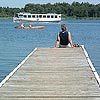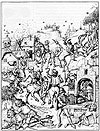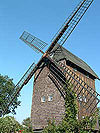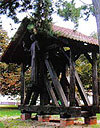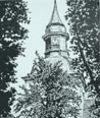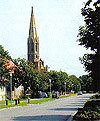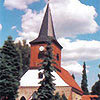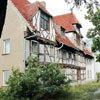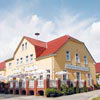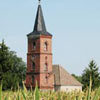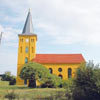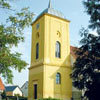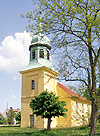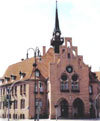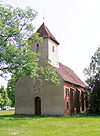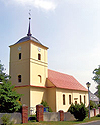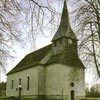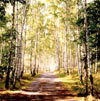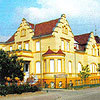From a little lilac town to an educational location
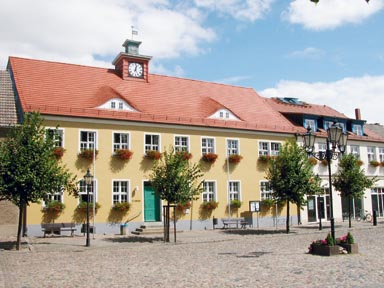
Of course the name Friesack has absolutely nothing to do with the legend because it was first mentioned in 1217 as vrysac and linguists trace the name back to the Slavic
breza � the 'birch'. In 1327 Friesack owns a castle and is described as civitas, town. From medieval Friesack there are only few witnesses as devastating firestorms razed the town from the 17th to the 19th century several times to the ground. Palace and town hall, churches, residences and barns were also affected. Two local brickyards profited from the re-building. Friesack enjoyed economical up-swing through the meliorations of the Havelland and Rhin Luch in the 18th century and thecauseway between Hamburg and Berlin in 1829. Farming and trade bloomed. When the industry developed villages and towns with the railway, the Friesacker people suffered due to wrong decision by their aldermen. Because they had only permitted the railway station to be built two kilometres from the village as one was afraid of noise and fumes. So Friesack stayed for a long time a typical farming town, with seven windmills and a market for livestock and artisan products, under which cobbles witnesses of long gone times were found. Today the market with the town hall shows itself very smart for the pump and lilac festivals. Friesack made a name for itself through peat extraction and patten production, the predominantly worn footwear in the country.
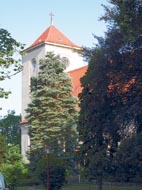
In 1870 there were 150 patten makers. A rarity was the nettle growing during and after the 1st World War near Fliederhorst, to win fibres. But the nettle factory was unprofitable and later attempts were also unsuccessful. For the byname Fliederstadt (lilac town), Friesack has to thank the beautification club, founded in 1897, whose members planted lilac along the roads and places. The lilac blossoming in May and the good reputation of the climatic health resort, approved in1928 let Berliner to discover this tranquil town. The summer visitors stimulated the economy. A dairy, sawmill, brewery and an oatmeal factory developed. In1939 14 pubs, 15 groceries, eight bakeries, five butchers and many other trades defined the picture of the town.On the 1st of May 1945 Russian and Polish federations moved into the town, which had hardly any war losses, started to burn inthe followingnight.During the GDR time agriculture and forestry dominatedFriesack's economy. Several LPG formed the LPG plant and animal production.
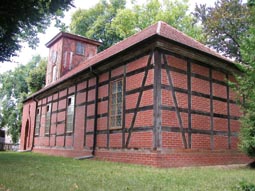
An engineer school for agricultural technique trained from 1950to 1990 a large part of the countries agrarian specialists and made the small town of Friesack known beyond the state borders. Now agrarian co-operatives worked the areas, grew forage maize for cattle herds, grain and potatoes. After the reunification one consciously linked the experience, usedthe chance to become a town of education. Not only with the co-operation school where slow and fast learners are being integrated into one school class. One part of the senior class centre Havelland with 2400 students and 82 teachers has its domicile at the area of the former engineer school. The industry-wide trainings centre for building industry contributes that Friesackrepresents itselfas youngas never before.But it doesn't contribute to the town's flair that several small shops have closed down. There is still a lot to do to make the townscape more attractive and that is not only the task of the Interessengemeinschaft 'Friesack soll sch�ner werden' (community of interest, Friesack should became more beautiful). The town's cultural and social life is being formed by numerous clubs. It has also become since 1993 the centre of the Amt with five communities. Part of Friesack is the village Zootzen, which attracts with its great woods and the Rhin nature friends and Wutzetz, a round village from Wendish times where equestrian sports is being enjoyed.
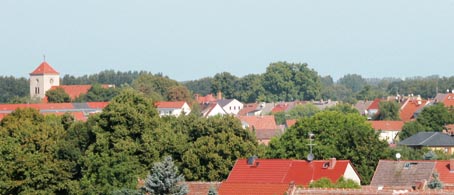
The pictures + contents were kindly made available by
Stadtmagazinverlag AS GmbH.
Photo: Stadtmagazinverlag AS

 Deutsch
Deutsch Nederlands
Nederlands Dansk
Dansk Österreichisch
Österreichisch Po Polsku
Po Polsku Italiano
Italiano Francaise
Francaise Portugiesisch
Portugiesisch




